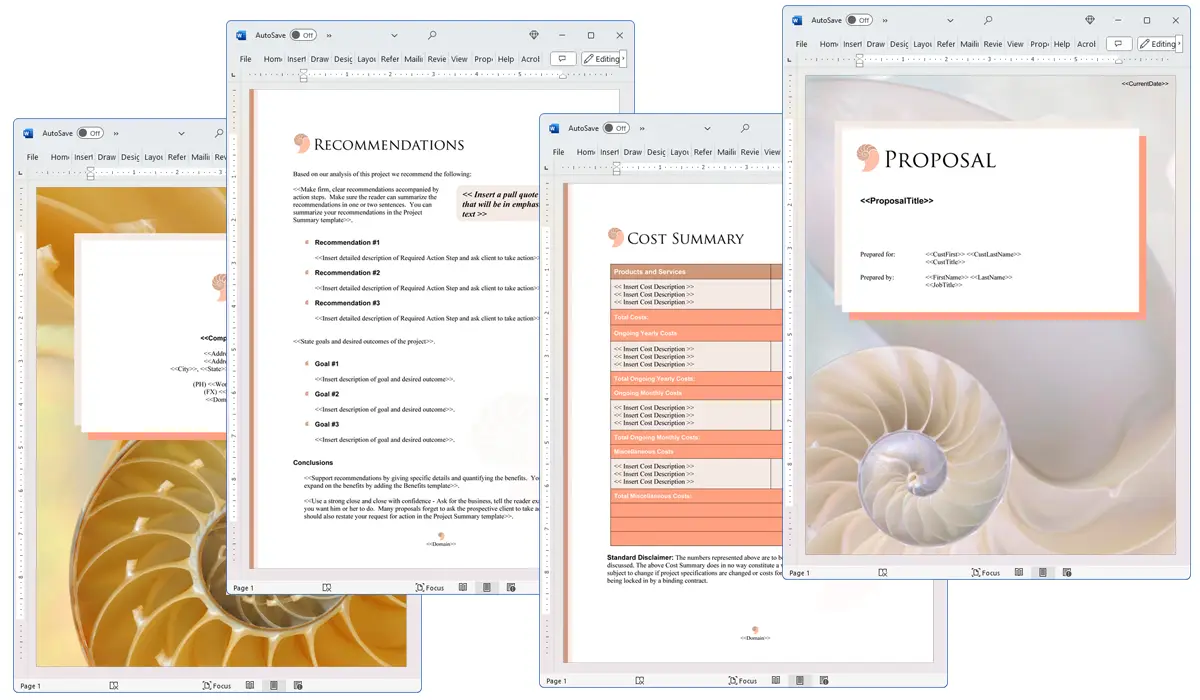What is the Flexibility chapter used for?
Proposal Kit Professional Bundle adds more design themes, all six Contract Packs,
a project management library, and Expert Edition software.

Illustration of Proposal Pack Concepts #18
We include this Flexibility chapter template in every Proposal Pack, along with thousands more. You assemble this chapter with others in various combinations to create custom-tailored business proposals, plans, reports, and other documents. Proposal Packs apply custom visual designs to the templates, giving the final documents a consistent professional finish.
 DOWNLOADABLE, ONE-TIME COST, NO SUBSCRIPTION FEES
DOWNLOADABLE, ONE-TIME COST, NO SUBSCRIPTION FEES
Overview of the Flexibility Chapter
In the field of business proposals, the Flexibility chapter is an important component that highlights the adaptability of a business or project. This chapter is designed to communicate to potential clients or partners how the proposed approach or solution can be adjusted to meet changing circumstances or specific needs. Including a Flexibility chapter demonstrates foresight and readiness to handle unpredictability, which is often appealing to stakeholders who value adaptable business practices.
How is the Flexibility Chapter Used?
The Flexibility chapter is used in a business proposal to showcase the proposer's capability to modify aspects of the proposal based on feedback, conditions, or unexpected challenges. It helps in building trust by showing potential clients that the business is prepared not only to deliver under ideal conditions but also capable of handling the unknown. This chapter often works in conjunction with other parts of a proposal, such as the methodology or implementation sections, to reinforce the message of adaptability.
What is Included in the Flexibility Chapter?
Typically, the Flexibility chapter includes:
- Examples of Past Adaptations: Instances where the business has successfully modified its approach in past projects.
- Scope for Customization: Details on how the services or products can be tailored to meet specific client needs or preferences.
- Response Strategies: Outline of strategies for dealing with potential changes or challenges during the project lifecycle.
- Resource Allocation: Information on how resources can be adjusted or reallocated should the project scope or timelines shift.
- Feedback Mechanisms: Description of the processes in place for ongoing client feedback and how this will be incorporated into the project workflow.
Use Case Examples for the Flexibility Chapter
- In a proposal for a software development project, including how the development process can scale based on user feedback.
- For a construction proposal, detailing how project timelines and resource use can adjust to unforeseen weather conditions or material supply issues.
- In a marketing agency proposal, describing how campaign strategies can pivot based on market trends or consumer behavior analytics.
- In a consultancy services proposal, outlining how the consultancy can modify its recommendations based on the regulatory environment or industry standards.
- In a health services proposal, illustrating how treatment or care protocols can be adapted based on individual patient needs or outcomes.
Key Takeaways
- The Flexibility chapter is important for demonstrating the proposer's ability to adapt to changes and customize services to client needs.
- Including this chapter helps build trust with potential clients by showcasing readiness to handle challenges.
- This chapter often contains examples of past flexibility, plans for customization, and strategies for responding to changes.
- It can be particularly effective in industries where conditions are prone to change, such as technology, construction, and marketing.
- The Flexibility chapter reinforces the overall adaptability and client-centric approach of a business proposal.

Illustration of Proposal Pack Legal #2
 What Our Clients Say
What Our Clients SayWith this product and their excellent customer support, your company’s offering will be professionally position. Their easy to use tools will make any company look like a Fortune 500 member! It would take a multi-person team to duplicate the work product. One non-creative person can look like an army of designers with an unlimited budget."
 4.7 stars, based on 845 reviews
4.7 stars, based on 845 reviewsRelated Chapters
Samples Using the Flexibility Chapter
Document Layouts Using the Flexibility Chapter

The Flexibility chapter and other chapters are integrated into a Word document as illustrated here in the Proposal Pack Medical #7 design theme. There are hundreds of design themes available, and every design theme includes the Flexibility chapter template.
A proper business proposal will include multiple chapters. This chapter is just one of many you can build into your proposal. We include the complete fill-in-the-blank template in our Proposal Pack template collections. We also include a library of sample proposals illustrating how companies in different industries, both large and small, have written proposals using our Proposal Packs. This template will show you how to write the Flexibility.
We include a chapter library for you to build from based on your needs. All proposals are different and have different needs and goals. Pick the chapters from our collection and organize them as needed for your proposal.
Using the Proposal Pack template library, you can create any business proposal, report, study, plan, or document.
 Ian Lauder has been helping businesses write their proposals and contracts for two decades. Ian is the owner and founder of Proposal Kit, one of the original sources of business proposal and contract software products started in 1997.
Ian Lauder has been helping businesses write their proposals and contracts for two decades. Ian is the owner and founder of Proposal Kit, one of the original sources of business proposal and contract software products started in 1997.By Ian Lauder
 Published by Proposal Kit, Inc.
Published by Proposal Kit, Inc.


 Cart
Cart
 Facebook
Facebook YouTube
YouTube X
X Search Site
Search Site